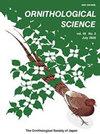西伯利亚白鹤在黑暗中的迁徙
IF 0.3
4区 生物学
Q4 ORNITHOLOGY
引用次数: 0
摘要
摘要本研究旨在确定白鹤是否在日落后定期飞行,以及白鹤在黑暗中继续迁徙的决定因素。根据东西伯利亚地区(2012-2021)的观测结果,4-69%的白鹤在夜间飞越观测点,而不考虑是否存在适合白鹤的有利环境因素,如湿地丰富的地区,并在黑暗中继续向不适合其降落的栖息地飞行。这表明它们在夜幕降临后继续迁徙的决定是由内部因素引起的,并有助于了解夜鹤迁徙现象。本文章由计算机程序翻译,如有差异,请以英文原文为准。
Migration of Siberian Crane Leucogeranus leucogeranus in darkness
Abstract This study aimed to identify whether Siberian Crane Leucogeranus leucogeranus regularly fly after sunset, and what determines a cranes' decision to continue its migration in darkness. Based on observations in East Siberia (2012–2021), 4–69% of cranes passed over observation points during the night, regardless of the presence of positive environmental factors suitable for cranes, such as wetland-rich areas, and continued in the dark towards areas with inappropriate habitat for their landing. This suggests that their decision to continue migrating after nightfall is induced by internal factors and contributes insights into the phenomenon of nocturnal crane migrations.
求助全文
通过发布文献求助,成功后即可免费获取论文全文。
去求助
来源期刊

Ornithological Science
ORNITHOLOGY-
CiteScore
1.20
自引率
0.00%
发文量
26
审稿时长
>12 weeks
期刊介绍:
Ornithological Science publishes reviews, original articles, short communications and comments covering all aspects of ornithology. Manuscripts are judged on the basis of their contribution of original data and ideas or interpretation. All articles are peer-reviewed by at least two researchers expert in the field of the submitted paper. Manuscript are edited where necessary for clarify and economy. Ornithological Science aims to publish as rapidly as is consistent with the requirements of peer-review and normal publishing constraints.
 求助内容:
求助内容: 应助结果提醒方式:
应助结果提醒方式:


